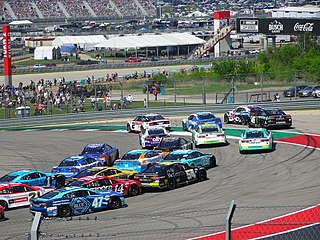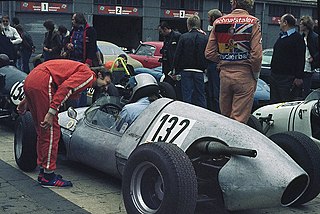Formula One is the highest class of auto racing sanctioned by the FIA.
Contents
Formula One or Formula 1 may also refer to:
Formula One is the highest class of auto racing sanctioned by the FIA.
Formula One or Formula 1 may also refer to:

Auto racing is a motorsport involving the racing of automobiles for competition. In North America, the term is commonly used to describe all forms of automobile sport including non-racing disciplines.

An open-wheel car is a car with the wheels outside the car's main body, and usually having only one seat. Open-wheel cars contrast with street cars, sports cars, stock cars, and touring cars, which have their wheels below the body or inside fenders. Open-wheel cars are built both for road racing and oval track racing. Open-wheel cars licensed for use on public roads, such as the Ariel Atom, are uncommon, as they are often impractical for everyday use.

Formula Two is a type of open-wheel formula racing category first codified in 1948. It was replaced in 1985 by Formula 3000, but revived by the FIA from 2009–2012 in the form of the FIA Formula Two Championship. The name returned again in 2017 when the former GP2 Series became known as the FIA Formula 2 Championship.

Formula Junior is an open-wheel formula racing class first adopted in October 1958 by the CSI. The class was intended to provide an entry level class where drivers could use inexpensive mechanical components from ordinary automobiles. The idea to form the new class came from Count Giovanni "Johnny" Lurani, who saw the need of a class for single-seater racing cars where younger drivers could take their first steps. It is often speculated that this class was founded as a reaction to Italy's lack of success in the 500 cc Formula Three, and although Italian marques dominated the first year of the formula, they were soon overtaken by British constructors.
David Paul Kennedy is a former racing driver from the Republic of Ireland. He was one of his country's first Grand Prix drivers, and is widely seen as having helped pioneer the Irish move into international racing.
Gary Thomas Brabham is an Australian former professional racing driver. He is the son of three-time World Formula One Champion Sir Jack Brabham and the brother of Le Mans winners Geoff and David Brabham.

American open-wheel car racing, generally known as Indy car racing, or more formally Indianapolis car racing, is a category of professional automobile racing in the United States. As of 2024, the top-level American open-wheel racing championship is sanctioned by IndyCar. Competitive events for professional-level, open-wheel race cars have been conducted under the auspices of various sanctioning bodies, tracing its roots as far back as 1902. A season-long, points-based, National Championship of drivers has been officially recognized in 1905, 1916, and each year since 1920. As such, for many years, the category of racing was known as Championship car racing. That name has fallen from use, and the term Indy car racing has become the preferred moniker.

Formula 5000 was an open wheel, single seater auto-racing formula that ran in different series in various regions around the world from 1968 to 1982. It was originally intended as a low-cost series aimed at open-wheel racing cars that no longer fit into any particular formula. The '5000' denomination comes from the maximum 5.0 litre engine capacity allowed in the cars, although many cars ran with smaller engines. Manufacturers included McLaren, Eagle, March, Lola, Lotus, Elfin, Matich and Chevron.

Formula racing is any of several forms of open-wheeled single-seater motorsport. The origin of the term lies in the nomenclature that was adopted by the FIA for all of its post-World War II single-seater regulations, or formulae. The best known of these formulae are Formula One, Formula E, Formula Two, Formula Three, regional Formula Three and Formula Four. Common usage of "formula racing" encompasses other single-seater series, including the IndyCar Series and the Super Formula Championship.
F1 is Formula One, the highest class of auto racing sanctioned by the FIA.

Formula Ford, also known as F1600 and Formula F, is an entry-level class of single-seater, open-wheel formula racing. The various championships held across the world form an important step for many prospective Formula One drivers. Formula Ford has traditionally been regarded as the first major stepping stone into formula racing after karting. The series typically sees career-minded drivers enter alongside amateurs and enthusiasts. Success in Formula Ford can lead directly to other junior formula series such as a Formula Renault 2.0 and Formula Three, or F1 Academy for female drivers, and previously the W Series, prior to the series folding.

The Formula 1 Powerboat World Championship is an international motorboat racing competition for powerboats organised by the Union Internationale Motonautique (UIM) and promoted by H2O Racing, hence it often being referred to as F1H2O. It is the highest class of inshore powerboat racing in the world, and as such, with it sharing the title of F1, is similar to Formula One car racing. Each race lasts approximately 45 minutes following a circuit marked out in a selected stretch of water, usually a lake, river, dock, or sheltered bay.

F1 2009 is a video game based on the 2009 season of the Formula One motor racing series. It was released on the Wii and PlayStation Portable in November 2009 for North America, PAL region and the United Kingdom. The game was also released on iOS on 14 December for £6.99. The PlayStation Portable version was also available as a download from the PlayStation Store from 16 November.

The GB3 Championship is a single seater motorsport series based in the United Kingdom. The championship is the UK's premier single-seater category, and is aimed at young racing drivers moving up from FIA Formula 4 championships or Karting. Having previously been known since 2013 as the BRDC Formula 4 Championship, the championship was renamed the BRDC British Formula 3 Championship with the backing of the FIA in March 2016. The championship was rebranded to GB3 Championship in August 2021.

FIA Formula 4, also called FIA F4, is an open-wheel racing car category intended for junior drivers. There is no global championship, but rather individual nations or regions can host their own championships in compliance with a universal set of rules and specifications.
F1000 or variation, may refer to:

Billy Edmund Albert Monger is a British racing driver who raced in British F4 in 2016 and 2017. He now works as a commentator/pundit and TV personality. He has been referred to by the nickname Billy Whizz, after the character in British comic The Beano.

The FIA Formula 3 Championship is a third-tier international single-seater racing championship and organised by the Fédération Internationale de l'Automobile (FIA). The championship launched in 2019 as a feeder series for the FIA Formula 1 World Championship and FIA Formula 2 Championships. It was the result of a merger between two third-tier single-seater racing championships, the GP3 Series and the FIA Formula 3 European Championship. This championship is part of the FIA Global Pathway consolidation project plan. Unlike its co-predecessor, the Formula 3 European Championship, the series runs exclusively in support of Formula One races.
The FIA Global Pathway from Karting to Formula One is a program developed by the Fédération Internationale de l'Automobile (FIA), the international sanctioning body for motorsports that is designed to assist racing drivers progress from karting to Formula One. The program was first developed in 2014 with the creation of the Formula 4 category, and follows a tiered structure, with drivers racing in increasingly-powerful cars. The Global Pathway represents the consolidation of feeder series to create a more linear approach to progressing into Formula One.

F1 2020 is the official video game of the 2020 Formula 1 and Formula 2 Championships developed and published by Codemasters. It is the thirteenth title in the Formula 1 series developed by the studio and was released on 7 July for pre-orders of the Michael Schumacher Edition and 10 July for the Seventy Edition on Microsoft Windows, PlayStation 4, Xbox One and, for the first time, Stadia. The game is the twelfth main series installment in the franchise, and it features the twenty-two circuits, twenty drivers and ten teams proposed in the provisional 2020 Formula 1 World Championship.